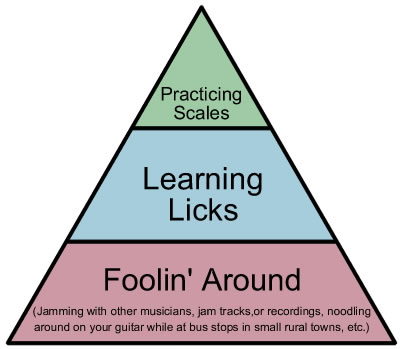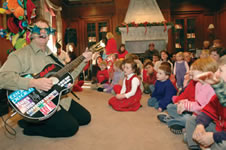 Welcome to Chef Hampton’s All-You-Can-Stand Improvisational Guitar Buffet. Our first course is boiled spinich–a bland, soggy scale exercise that is nonetheless packed with vitamins and minerals. Fortified with clear diagrams and video clips, this meal is an important part of a beginning guitarist’s diet. Bon Appetit!
Welcome to Chef Hampton’s All-You-Can-Stand Improvisational Guitar Buffet. Our first course is boiled spinich–a bland, soggy scale exercise that is nonetheless packed with vitamins and minerals. Fortified with clear diagrams and video clips, this meal is an important part of a beginning guitarist’s diet. Bon Appetit!
In Improvising 101, the appetizer to today’s meal, I introduced the A minor pentatonic scale, which, despite its complicated-sounding name, is the simplest scale for budding improvisers to learn and use. You may want to give it a taste before continuing, because the next course is going to be…how should I put it…a character-building experience for your taste buds.
I’m talking about repetitious practicing–in this case, playing the A minor pentatonic scale up and down, up and down, for a good while. There’s no way to avoid this kind of repetition if you want to learn to improvise with spontaneity and grace. In fact, practicing scales is part of the Improvisational Guitarist’s Nutrition Pyramid ™:

As you can see, foolin’ around is the foundation of an improviser’s practice routine. Foolin’ around includes using your intuition, experimenting, doing it the wrong way. Play Mary Had a Little Lamb backwards. String your guitar with dental floss. You’ll be participating in a time-honored tradition of tinkerers and tweakers, from Leo Fender to Leo Kottke.
Learning other people’s licks is also important. While great artists strive to go beyond imitation, they always draw inspiration from their predecessors. When you listen to a great guitarist improvising, what you’re hearing the sum of all the music they’ve learned before, spiced with their own creative genius.
But repetitious scale practice is an important part of your diet too. So let’s dig in. To start with, here are a couple of ways of looking at the scale pattern we’re using–first a diagram, and then with tablature:

Above is a diagram of a four-fret section of your fretboard. The horizontal lines are the guitar strings, with the high E string at the top and the low E string at the bottom, and the vertical lines are the fret wires. Each dot is a note in the scale pattern, and the number tells you which finger to use. Those orange circles are “A” notes, which are the “root” notes of the Am Pentatonic Scale. We’ll talk more about root notes some other time.
You might be wondering where this scale is supposed to be played. We’re going to play in 5th position, meaning that the first finger is going to hang out on the 5th fret, but this pattern can be played anywhere up and down the neck. Move the hand up the neck, and you’re playing in a higher key. Move it down the neck, and you’re playing in a lower key. Scratch under your armpit and make hooting noises, and you’re a mon key.
Back to the scale. Here’s the tablature version of the scale pattern:

Let’s memorize this scale pattern. It’s easy, because with this pattern, there are just two notes per string, and one of those notes is on the 5th fret. The other note is either played with your pinkie (on the 8th fret) or with your ring finger (on the 7th fret). Let’s call strings with notes on the 5th and 8th frets pinkie strings, and strings with notes of 5th and 7th frets ring finger strings.
Memorize this: The 6th, 2nd, and 1st strings are pinkie strings. All others are ring finger strings.
Got that memorized? OK, we’re almost ready to play the scale. But first, the Six Scale Practice Commandments. It’s really, really important that you practice this scale using proper technique:
- Thou shalt avoid mistakes by playing slowly
- Thou shalt place thy thumb behind the neck so that thy fingers may part like the Red Sea
- Each note shalt sound good
- Thou shalt play in rhythm
- Thou shalt use alternate picking (alternating downstrokes and upstrokes)
- Thou shalt not sound choppy, but with one note flowing into the next
Now watch a video of me playing the Am Pentatonic scale using impeccable technique. New Orleans, here I come!
Now it’s your turn. I recommend practicing this in four five-minute intervals, with a brief break in between. You want to stay focused as you practice, and after five minutes people’s minds tend to wander. With this practice schedule, in a week you’ll be smoooove.
I can’t stress enough how important it is for you to get off on the right foot and follow the Six Commandments. Just look what happened to Larry Underwood of Fremont, CA. Larry rushed when practicing his scales. Now he plays Barney the Dinosaur covers for bored kindergartners:

Don’t end up like Larry!
Eat everything off your plate and I’ll be back in a while with dessert…

Comments 13
Hi,
Well I was reading your tutorials and decided to drop you a note. I’m 26. It’s been 10 years that I’ve been trying to learn “how to play that thing” now and then. But no luck. Everytime i decide to start, something disturbs! When i was in high-school it was other fun things like playing water polo or hitting the puck on the ice. Then when i was at the university it was those exams which kept me away from guitar. I have a guitar. It is a washburn classical and it’s just waiting there under my bed for me to grab it and start playing. No luck! I don’t want to hire a guitar teacher because my schedule is very tight (yes yes…i work hard..i’ve always worked hard).
Do you think your blog can help me play my guitar? If it can help I am more than ready to be on this blog at least 30 minutes everyday with no exception.
All the best!
Marv
Ive got this nailed down. Wheres my dessert? im still starving :))
It has been a while since dinnertime, hasn’t it? Maybe I can get to dessert soon. Thanks for reminding me.
hi there
i just bought a guitar to start play on it
but i’m 00.00% guitar player i have only the wanting to learn ! do u think it is enough to learn how to play it?
you got any more scales made that way. I learned that quick! Thanks!!!!!
I think your sites are teriffic, but there is one thing, I’m sure of…. I wish you would have more videos, explaining this part of the lessons, since, I am such a visual person.
Not sure if that is posible with what your teaching us, at this point.
Great site everything you have done and show is a great help to us new guitarists…I must agree with Lisa the videos portions help a great deal and they make it much easier to learn…My question to you is this…could you or more would you do a few videos of some of the songs you have listed mabye like “Take me home country roads” or “Puff the magic dragon” (for my kids) :leaving on a jet plane” I for one would appreciate it very much…any song would do but those are my choices but anything you could put together would be fantastic..Thanks again for you dedication to the site guitar playing and all your help thus far…
thanks again.
Dave
hey lisa, go rent the movie “pick of destiny (jack black)” and play it on a DVD player that has “A-B” looping, and “ZOOM”, then Download the tab for master exploder. take what you need from both sources and in no time you will be improvising allover the place. im a visual learner 2
Hey Dave,
I thought about doing that, but the hassle with copyright issues was too great. 🙁
I am producing a DVD right now that will have lots of songs on it. You can subscribe to my newsletter to be notified when it comes out, sometime in late 2008 probably.
Rob
Thanks for all you have shared with us Rob. I live about 45 min outside of Seattle myself and still consider myself a newbie. A minor pentatonic scale is my favorite. Even though its a grim reminder of how much I would love bigger hands its still a fav of mine.
If I could, I would come see you. You are a really amazing teacher and I am so glad you were kind enough to take the time to share all of these lessons. I’m glad I came across your site and will have you bookmarked for good.
Thanks!
Rob,
Good stuff on the minor penatonic; I’ve actually already done some improving already on this scale and love it.
Watching your video though I noticed on the bottom turnaround you lifted your index finger off of the A when you went to the C; I was originally taught to keep the finger down when you’re coming back to a note?
Any thoughts?
Mike
Hey Mike,
Great advice. If I were playing the scale faster, my first finger would have stayed down–it’s unnecessary to pick it up.
At that slow speed, it really doesn’t matter, though I’m a bit surprised to see my finger lift… 🙂
Rob
Pentatonic scales are the first important ones every guitarist or musician should learn when learning improvisation, after that if you want to move to the next level you have to learn modes of the major scale and other scales and when to use them because they are very important to every musician that wants to write his own songs, great post, thanks.